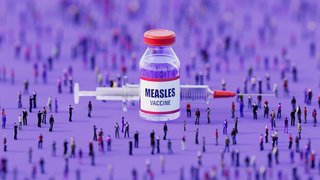How cervical cancer screening with HPV testing is saving lives
May 22, 2025

Decades ago, cervical cancer was considered one of the deadliest types of cancer among women in the U.S., according to the Centers for Disease Control and Prevention (CDC). Today, the American Cancer Society reports that the death rate has been more than halved thanks to early detection of cervical cancer and its precancerous condition along with the human papillomavirus (HPV) vaccine.
However, confusion over cervical cancer screening and HPV testing remains common. Patients frequently ask, “Will an HPV infection give me cervical cancer? What is involved in cervical cancer screening? When should I get tested?”
Now is the perfect time to review facts about cervical cancer, HPV-associated risks, and screening recommendations. We’ll also look at self-collected tests that have recently sparked interest.
Why do newer guidelines include HPV testing?
HPV is an extremely common virus transmitted through intimate skin-to-skin contact. HPV exposure from sexual contact is the cause of nearly all cervical cancer. It is so prevalent that most sexually active individuals will get it at some point in their lives, whether they realize it or not. With at least 30 types of HPV infecting the genital tract, most infections come and go without symptoms or consequences. However, there are at least 14 strains that carry varying levels of risk for cancer.
The HPV vaccine, first approved by the Food and Drug Administration (FDA) in 2006, has significantly reduced the threat of cancer-causing HPV. It is safe and most effective if given to all children around age 9 and up through age 26. It can also be obtained by people with a cervix age 27 to 45 years but is less protective at older ages. The HPV vaccine protects against seven of the HPV types known to cause cervical cancer but only if the recipient is not already infected with those types. Even with HPV vaccination, there is no guaranteed safeguard as it does not prevent infection by all the HPVs that cause cervical cancer. So, those who have already received the vaccine should still get screened.
Related reading: HPV vaccine: Preventing a sexually transmitted cancer
Screening options: Pap tests vs. HPV tests

Anyone with a cervix needs screening for cervical cancer, according to national guidelines. People should ask their health care provider which test is right for them. Screening varies by age, risk level, and results of past testing.
A Pap test requires use of a speculum to collect cells directly from the cervix, targeting the area most likely to harbor precancer or cancer. The sample is sent to a lab, where it is examined for cellular abnormalities. The results can sometimes be falsely negative even when there is something wrong, and Pap test results can also be abnormal when there is actually nothing wrong. With these uncertainties, Pap tests cannot give a definite diagnosis. Rather, they identify the patients who need further evaluation.
HPV tests, on the other hand, don’t require a sample directly from the cervix, which helps when the cervix is not easily seen or reached on exam. They are also much more sensitive, missing fewer cases of cancer and precancer than Pap tests. Their purpose is to detect the presence of 14 specific human papillomaviruses (HPV).
It is so effective that HPV testing as the first step of screening is better at preventing cervical cancer than Pap tests alone (although a Pap test may be the next step if your HPV test is positive). Only FDA-approved HPV tests should be used (check with your provider to be sure that is the case). HPV testing is generally for people with a cervix who are aged 30 years and over. If negative, there is very low risk of a problem, and a negative HPV test does not need to be repeated for five years.
Providers may still offer some patients ages 30 and over both HPV and Pap testing together (usually immunocompromised patients), or in the many places where “primary” HPV testing (HPV test as main screening test) is not yet available.
Related reading: Pap smears are safe – before, during and after pregnancy
Is self-collected HPV testing an option?

Cancer screenings can save lives, but they’re only effective if they are accessible to patients. At least half of cervical cancers happen in those who have never been screened or not screened within the past five years.
There are many reasons why patients may not get a Pap test or HPV test: expense, personal or cultural beliefs about sex and reproduction, fear of pain or discomfort, embarrassment or anxiety, physical challenges, and a general lack of access or awareness, just to name a few. Underserved communities and the uninsured have higher rates of cervical cancer due to lack of screening.
Fortunately, we are making progress to address some of these barriers and inequities. The FDA has recently approved three devices for self-collection of HPV tests. Self-collection should be used only by “average risk” individuals without symptoms that indicate cervical cancer may already be present. Therefore, people with any of the following should not use self-collection as a screening method and should see a provider in person:
- Patients with abnormal immune systems (HIV infection, lupus, transplant patients, use of immune suppressant medications)
- History of abnormal Paps or HPV tests
- History of cervical precancer
- DES (diethylstilbestrol) exposure before birth. DES, or diethylstilbestrol, was a synthetic estrogen prescribed between 1938 and 1971 to prevent miscarriage.
- Abnormal vaginal bleeding
- Abnormal vaginal discharge
Multiple studies found that HPV test results taken from self-collected samples are as accurate as those collected by clinicians. Major cervical cancer screening guidelines are expected to include HPV self-collection soon. Pap tests cannot be self-collected. If the HPV test is positive, a pelvic exam will be needed later to collect a Pap smear or other test to see if further investigation is needed.
Two self-collection HPV testing devices have now been approved by the FDA for use in health care settings such as doctors’ offices or pharmacy-based clinics. One resembles a cotton swab and the other a tiny brush. A third wand-like device is now FDA-approved for self-collection at home but is not yet available for purchase (as of May 2025). All are inserted vaginally, similar to a tampon. Instructions should be followed carefully for each system to get the most accurate results.
HPV tests are available for purchase online, but consumers should be cautious since the samples must be collected and transported to labs under very specific conditions. All self-collection HPV kits tests go to a lab for testing; you do not get a result at home. Clinician support is also essential to ensure you are a candidate for self-collection and to make sure abnormal results are addressed correctly. While self-collection can eliminate some barriers to cervical cancer screening, it is not a home test to be done on your own without lab and clinician support.
As HPV self-collection becomes more widely available, it is worth a conversation with your primary care or Ob/Gyn provider to determine whether it’s right for you.
What should I do after I get screened?
If your HPV or Pap test results are negative, your provider will let you know when the cervical cancer screening should be repeated. If either of these tests are abnormal, you may need to repeat the test in one or three years. Keep in mind that these results do not automatically signal a cancer diagnosis.
If you test positive for specific high-risk HPV types and/or your Pap results show certain abnormalities, you may need a colposcopy, a procedure during which your physician will use a speculum and magnifying scope to closely examine the cervix. If an abnormality is found, a small biopsy is done to see if precancer or early cancer are present. Most biopsy results do not require treatment. If precancer is found, it is usually easy to treat, often right in the office.
If cervical cancer is found (this is rare), UT Southwestern’s nationally ranked Harold C. Simmons Comprehensive Cancer Center and our team of gynecologic oncologists are ready to deliver expert care. When it comes to treatment plans, the Simmons Cancer Center offers a full spectrum of options, ranging from surgery to radiation therapy and chemotherapy to clinical trials that provide medications and procedures that aren’t available anywhere else. The cancer center also supports patients through other services, including nutrition counseling, support groups, and survivorship seminars.
Related reading: Cervical Cancer Awareness Guide
Don’t be afraid of HPV testing
Because HPV is often spread through sexual contact, it tends to be accompanied by a negative social stigma.
The truth is it’s a highly prevalent virus. It often lies dormant for months or years and is usually asymptomatic. In most cases, your immune system fights it off, and it disappears.
HPV testing is becoming the dominant method of screening for cervical cancer, and it should be normalized in the same way we check for cholesterol or blood pressure. While it may be an uncomfortable subject to address, HPV testing is the best way to prevent cervical cancer or detect it early when it is easiest to treat.
To talk with an expert about cervical cancer or screening recommendations, call 214-645-3838 or request an appointment online.











